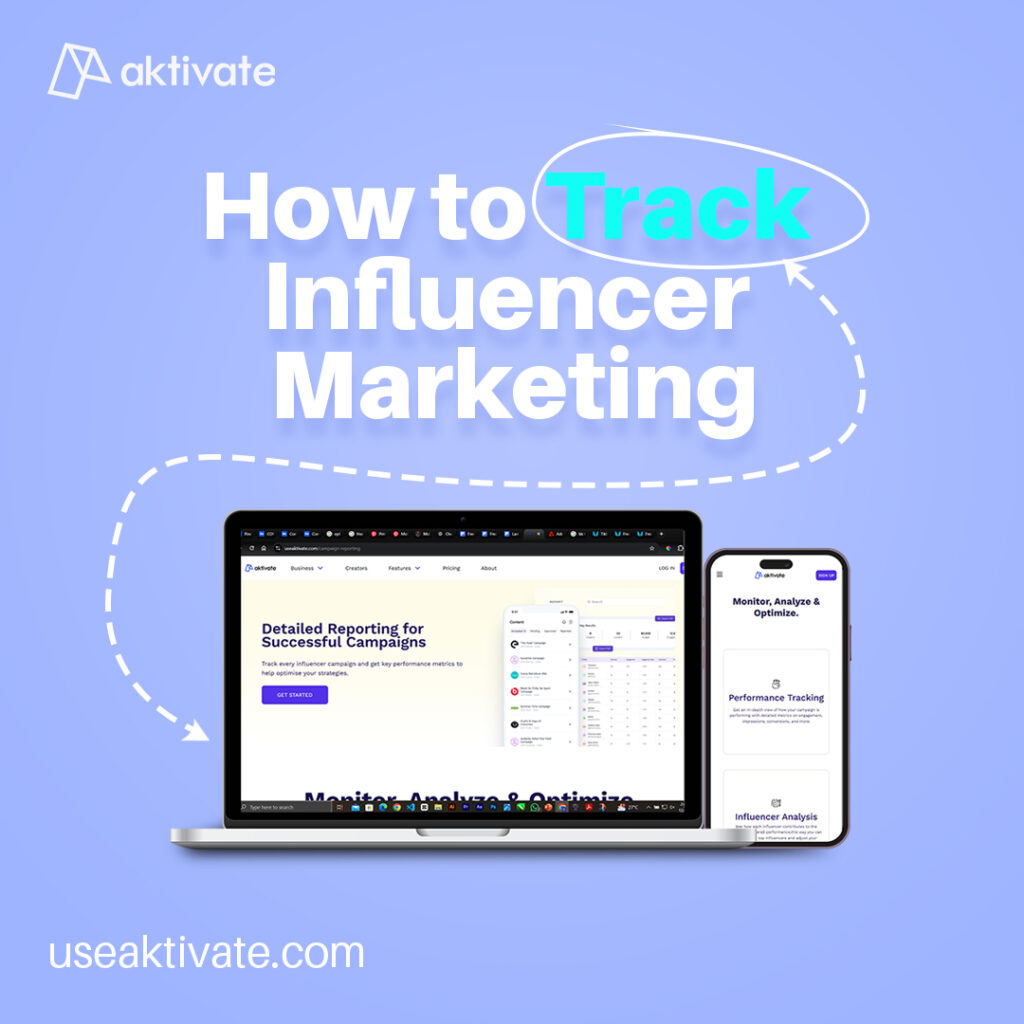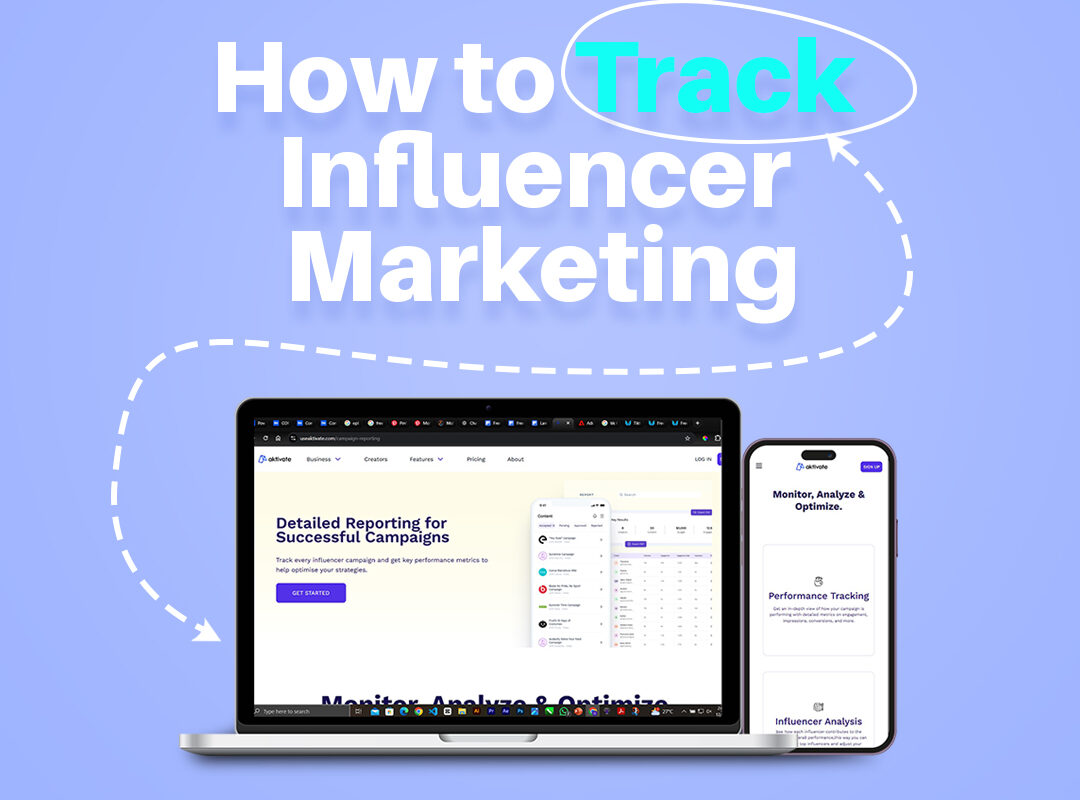Influencer marketing is powerful for reaching new audiences and building brand credibility. However, tracking its effectiveness is essential to ensuring that your campaigns deliver value. Knowing how to track influencer marketing helps brands measure engagement, assess return on investment (ROI), and refine future strategies.
Learn how to track influencer marketing effectively, utilizing the best tools, metrics, and strategies to measure your campaign’s impact.

Define Your Campaign Goals
Tracking begins with setting clear campaign goals. Your goals will determine which metrics to track and what success looks like for your brand. Common influencer marketing goals include:
- Brand Awareness: Increasing visibility and recognition.
- Engagement: Encouraging likes, comments, shares, and saves.
- Traffic: Driving visitors to your website or specific landing pages.
- Conversions: Generating sales, sign-ups, or other actions.
Each goal requires a different approach to tracking. For example, if your goal is brand awareness, metrics like reach and impressions will be crucial. However, if conversions are your focus, you’ll want to track metrics like click-through rates and sales.
Use UTM Parameters for Link Tracking
UTM parameters are a powerful way to track influencer-driven traffic. These small pieces of code added to a URL allow you to see exactly where your website traffic is coming from. By customizing UTM parameters for each influencer, you can monitor the effectiveness of individual posts or stories.
To set up a UTM link, use Google’s Campaign URL Builder. Include information such as campaign name, source (the influencer’s name or handle), and medium (Instagram, YouTube, etc.). When users click the link, Google Analytics tracks their journey, showing you which influencers drive the most traffic.
UTM tracking is especially useful when working with multiple influencers, as it helps you compare their performance.
Track Engagement Metrics
Engagement is one of the best indicators of a successful influencer campaign. Engagement metrics help you understand how audiences respond to the content, indicating interest and affinity for your brand. Important engagement metrics include:
- Likes and Comments: Show the level of immediate interaction.
- Shares and Saves: Indicate deeper interest and willingness to share with others.
- Story Replies and Poll Responses: For campaigns on Instagram Stories, these actions show real-time interaction.
Most social media platforms, including Instagram, TikTok, and YouTube, provide engagement analytics to influencers. To measure the engagement rate, use the formula:
Engagement Rate = (Total Engagements / Total Followers) x 100
A high engagement rate indicates strong audience interest, while a low rate may signal that the content missed the mark.
Monitor Reach and Impressions
Reach and impressions are vital metrics for campaigns focused on brand awareness. Reach is the number of unique users who see the content, while impressions count the total number of times the content is displayed. Therefore, impressions may be higher than reach if users view the content multiple times.
Tracking reach and impressions helps you understand the overall visibility of your campaign. These metrics also help in comparing different influencers and determining who can drive the most exposure for your brand.
Platforms like Instagram, Facebook, and TikTok offer reach and impressions data for business accounts. Ask influencers to share this data if it’s relevant to your campaign goals.
Use Conversion Tracking for Sales and Sign-Ups
If your campaign aims to drive conversions—such as purchases or sign-ups—conversion tracking is essential. Tracking conversions shows how many users moved from viewing influencer content to completing a desired action, helping you calculate ROI.
How to Track Conversions:
- Promo Codes: Give each influencer a unique promo code for their followers. This lets you track how many sales came from each influencer.
- Affiliate Links: Use affiliate links to attribute conversions to specific influencers. Many affiliate platforms, like ShareASale or RewardStyle, allow you to track purchases and even calculate commission-based payouts.
- Pixel Tracking: Install tracking pixels, like Facebook Pixel or Google Tag, on your website. These pixels track actions users take after clicking through an influencer’s content.
Using conversion tracking tools lets you attribute sales accurately and helps in calculating ROI for each influencer.
Analyze Audience Demographics
Understanding who engages with your influencer marketing helps refine targeting and optimize future campaigns. Many social media platforms provide demographic data on users who interact with influencer content, including age, gender, location, and interests.
Ask influencers to share their audience demographics. Ensure the influencer’s audience aligns with your target demographic to maximize the campaign’s impact. For example, if your product targets young adults, partnering with influencers whose audience is primarily teenagers may not yield the desired results.
When influencer audiences match your target market, engagement, conversions, and ROI tend to improve.
Use Influencer Marketing Platforms for Streamlined Tracking
Managing multiple influencers can become complex. Using an influencer marketing platform like Aktivate simplifies the process. These platforms offer features for campaign management, influencer discovery, and tracking metrics, making it easier to oversee and analyze campaigns.
Aktivate, for example, provides campaign reporting that tracks metrics like engagement, impressions, and conversions across all influencers. This centralizes data and saves time, allowing you to monitor campaign performance from one place rather than gathering reports from individual influencers.
Benefits of Using a Platform:
- Streamlined reporting and analytics
- Centralized access to performance metrics
- Tools for managing influencer contracts and payments
Platforms like Aktivate also help track individual influencer performance, so you can identify top-performing influencers and prioritize them in future campaigns.
Calculate Return on Investment (ROI)
ROI measures the profitability of your influencer marketing efforts, showing whether the campaign generated more revenue than it cost. To calculate ROI, use the following formula:
ROI = (Revenue – Campaign Cost) / Campaign Cost x 100
For example, if you spent $5,000 on a campaign and generated $10,000 in sales, your ROI would be 100%. Positive ROI indicates a successful campaign, while negative ROI suggests adjustments are needed.

ROI calculation helps you allocate your budget wisely and ensures your influencer marketing efforts drive financial returns.
Gather Qualitative Feedback
Numbers tell part of the story, but qualitative feedback provides deeper insight. Look at comments on influencer posts, audience questions, and feedback to gauge sentiment toward your brand.
Qualitative Data to Collect:
- Comments on influencer posts about your brand
- Direct messages or mentions of your brand on social media
- Feedback from influencers on audience response
Tracking qualitative data helps identify areas for improvement and discover what resonates with your target audience. For example, if followers frequently mention your product’s quality, you can emphasize this in future campaigns.
Refine Future Campaigns Based on Insights
Tracking influencer marketing provides insights that shape future campaigns. Use data on engagement, reach, conversions, and audience feedback to refine your strategy. Identify which influencers perform best, which content types generate the most interest, and which messages resonate.
As a result, your next campaign can be more targeted and effective. Continuously optimizing your influencer marketing approach based on insights ensures long-term success and maximizes the impact of each campaign.
Takeaway
Knowing how to track influencer marketing is crucial for effective campaigns. From setting goals and using UTM parameters to calculating ROI and refining strategies, tracking provides a roadmap to achieving measurable success.
With clear objectives, the right tools, and data-driven insights, your brand can make the most of influencer marketing. Each campaign becomes an opportunity to connect with audiences, build loyalty, and drive growth in a competitive market.





